Exhibit 99.1
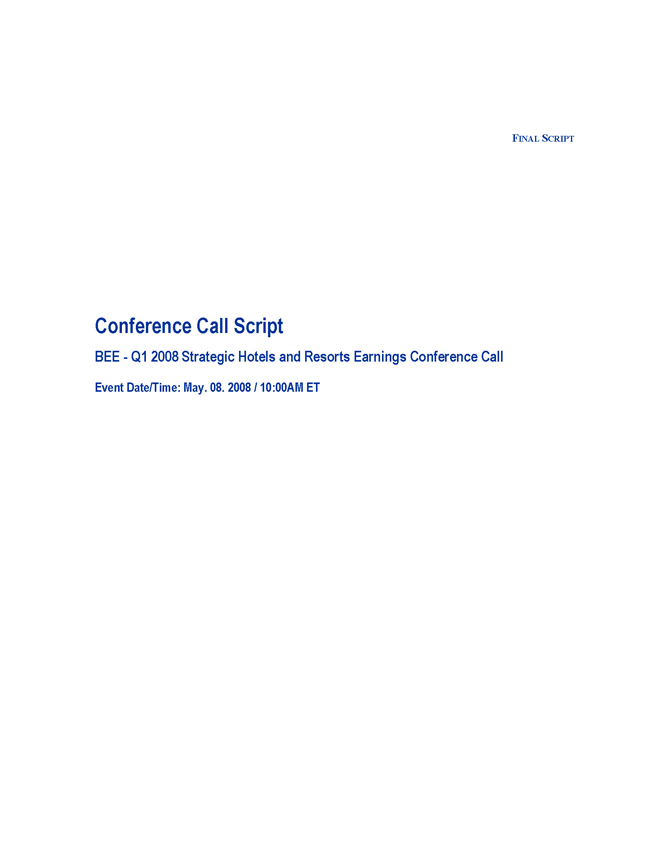
Exhibit 99.1
Final Script
Conference Call Script
BEE—Q1 2008 Strategic Hotels and Resorts Earnings Conference Call
Event Date/Time: May. 08. 2008 / 10:00AM ET
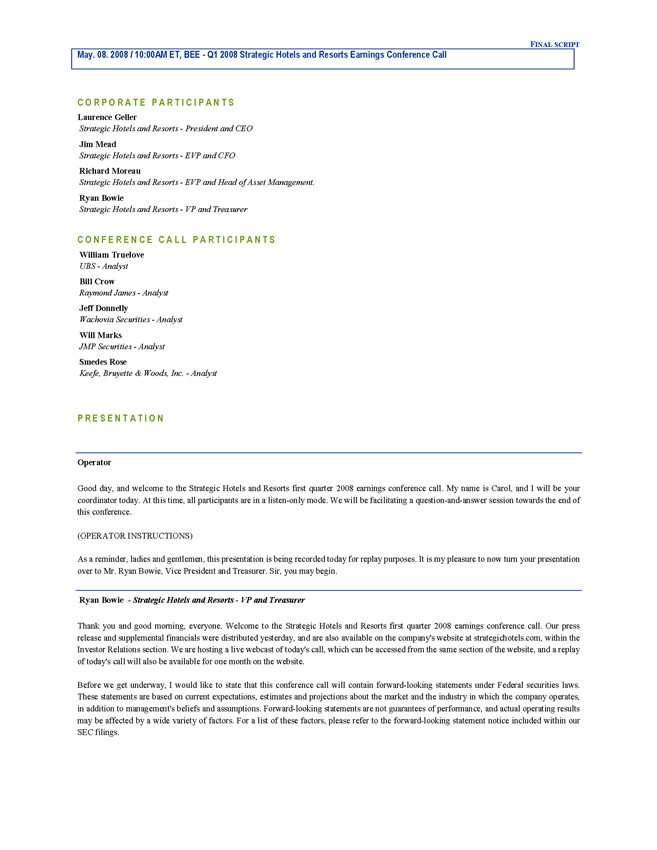
Final script
May. 08. 2008 / 10:00AM ET, BEE - Q1 2008 Strategic Hotels and Resorts Earnings Conference Call
CORPORATE PARTICIPANTS
Laurence Geller
Strategic Hotels and Resorts—President and CEO
Jim Mead
Strategic Hotels and Resorts—EVP and CFO
Richard Moreau
Strategic Hotels and Resorts—EVP and Head of Asset Management.
Ryan Bowie
Strategic Hotels and Resorts—VP and Treasurer
CONFERENCE CALL PARTICIPANTS
William Truelove
UBS—Analyst
Bill Crow
Raymond James—Analyst
Jeff Donnelly
Wachovia Securities—Analyst
Will Marks
JMP Securities—Analyst
Smedes Rose
Keefe, Bruyette & Woods, Inc.—Analyst
PRESENTATION
Operator
Good day, and welcome to the Strategic Hotels and Resorts first quarter 2008 earnings conference call. My name is Carol, and I will be your coordinator today. At this time, all participants are in a listen-only mode. We will be facilitating a question-and-answer session towards the end of this conference.
(OPERATOR INSTRUCTIONS)
As a reminder, ladies and gentlemen, this presentation is being recorded today for replay purposes. It is my pleasure to now turn your presentation over to Mr. Ryan Bowie, Vice President and Treasurer. Sir, you may begin.
Ryan Bowie —Strategic Hotels and Resorts—VP and Treasurer
Thank you and good morning, everyone. Welcome to the Strategic Hotels and Resorts first quarter 2008 earnings conference call. Our press release and supplemental financials were distributed yesterday, and are also available on the company’s website at strategichotels.com, within the Investor Relations section. We are hosting a live webcast of today’s call, which can be accessed from the same section of the website, and a replay of today’s call will also be available for one month on the website.
Before we get underway, I would like to state that this conference call will contain forward-looking statements under Federal securities laws. These statements are based on current expectations, estimates and projections about the market and the industry in which the company operates, in addition to management’s beliefs and assumptions. Forward-looking statements are not guarantees of performance, and actual operating results may be affected by a wide variety of factors. For a list of these factors, please refer to the forward-looking statement notice included within our SEC filings.
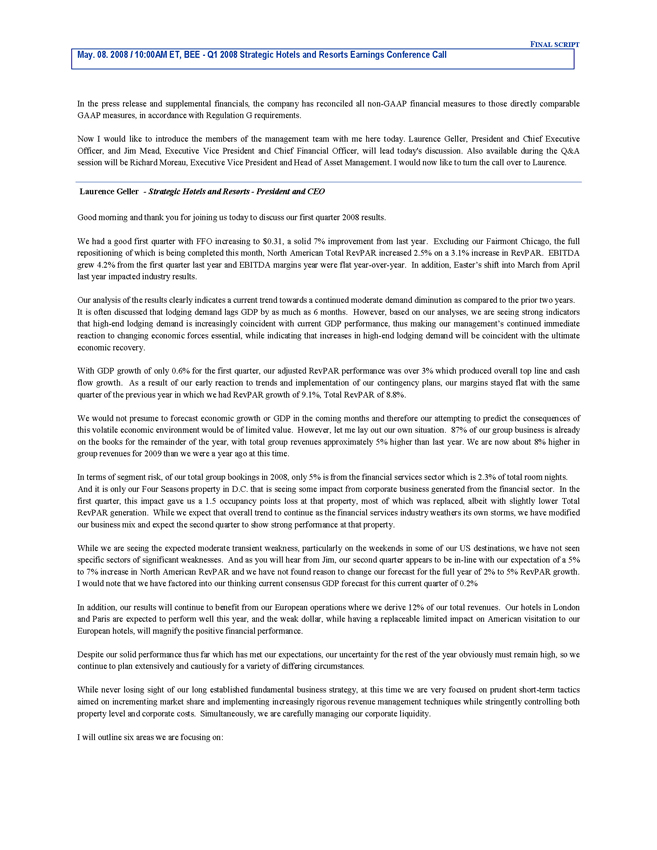
Final script
May. 08. 2008 / 10:00AM ET, BEE - Q1 2008 Strategic Hotels and Resorts Earnings Conference Call
In the press release and supplemental financials, the company has reconciled all non-GAAP financial measures to those directly comparable GAAP measures, in accordance with Regulation G requirements.
Now I would like to introduce the members of the management team with me here today. Laurence Geller, President and Chief Executive Officer, and Jim Mead, Executive Vice President and Chief Financial Officer, will lead today’s discussion. Also available during the Q&A session will be Richard Moreau, Executive Vice President and Head of Asset Management. I would now like to turn the call over to Laurence.
Laurence Geller —Strategic Hotels and Resorts—President and CEO
Good morning and thank you for joining us today to discuss our first quarter 2008 results.
We had a good first quarter with FFO increasing to $0.31, a solid 7% improvement from last year. Excluding our Fairmont Chicago, the full repositioning of which is being completed this month, North American Total RevPAR increased 2.5% on a 3.1% increase in RevPAR. EBITDA grew 4.2% from the first quarter last year and EBITDA margins year were flat year-over-year. In addition, Easter’s shift into March from April last year impacted industry results.
Our analysis of the results clearly indicates a current trend towards a continued moderate demand diminution as compared to the prior two years.
It is often discussed that lodging demand lags GDP by as much as 6 months. However, based on our analyses, we are seeing strong indicators that high-end lodging demand is increasingly coincident with current GDP performance, thus making our management’s continued immediate reaction to changing economic forces essential, while indicating that increases in high-end lodging demand will be coincident with the ultimate economic recovery.
With GDP growth of only 0.6% for the first quarter, our adjusted RevPAR performance was over 3% which produced overall top line and cash flow growth. As a result of our early reaction to trends and implementation of our contingency plans, our margins stayed flat with the same quarter of the previous year in which we had RevPAR growth of 9.1%, Total RevPAR of 8.8%.
We would not presume to forecast economic growth or GDP in the coming months and therefore our attempting to predict the consequences of this volatile economic environment would be of limited value. However, let me lay out our own situation. 87% of our group business is already on the books for the remainder of the year, with total group revenues approximately 5% higher than last year. We are now about 8% higher in group revenues for 2009 than we were a year ago at this time.
In terms of segment risk, of our total group bookings in 2008, only 5% is from the financial services sector which is 2.3% of total room nights.
And it is only our Four Seasons property in D.C. that is seeing some impact from corporate business generated from the financial sector. In the first quarter, this impact gave us a 1.5 occupancy points loss at that property, most of which was replaced, albeit with slightly lower Total RevPAR generation. While we expect that overall trend to continue as the financial services industry weathers its own storms, we have modified our business mix and expect the second quarter to show strong performance at that property.
While we are seeing the expected moderate transient weakness, particularly on the weekends in some of our US destinations, we have not seen specific sectors of significant weaknesses. And as you will hear from Jim, our second quarter appears to be in-line with our expectation of a 5% to 7% increase in North American RevPAR and we have not found reason to change our forecast for the full year of 2% to 5% RevPAR growth. I would note that we have factored into our thinking current consensus GDP forecast for this current quarter of 0.2%
In addition, our results will continue to benefit from our European operations where we derive 12% of our total revenues. Our hotels in London and Paris are expected to perform well this year, and the weak dollar, while having a replaceable limited impact on American visitation to our European hotels, will magnify the positive financial performance.
Despite our solid performance thus far which has met our expectations, our uncertainty for the rest of the year obviously must remain high, so we continue to plan extensively and cautiously for a variety of differing circumstances.
While never losing sight of our long established fundamental business strategy, at this time we are very focused on prudent short-term tactics aimed on incrementing market share and implementing increasingly rigorous revenue management techniques while stringently controlling both property level and corporate costs. Simultaneously, we are carefully managing our corporate liquidity.
I will outline six areas we are focusing on:
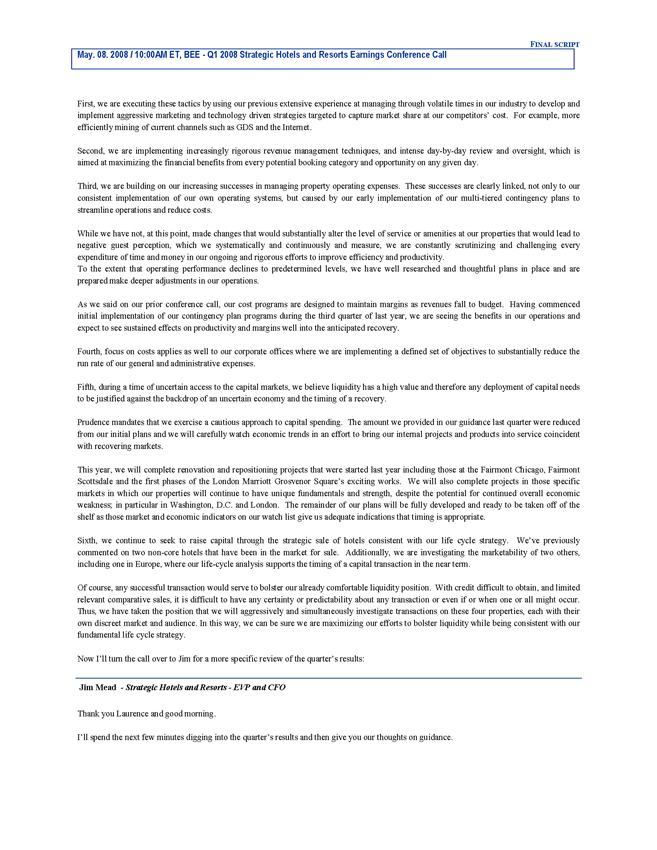
Final script
May. 08. 2008 / 10:00AM ET, BEE - Q1 2008 Strategic Hotels and Resorts Earnings Conference Call
First, we are executing these tactics by using our previous extensive experience at managing through volatile times in our industry to develop and implement aggressive marketing and technology driven strategies targeted to capture market share at our competitors’ cost. For example, more efficiently mining of current channels such as GDS and the Internet.
Second, we are implementing increasingly rigorous revenue management techniques, and intense day-by-day review and oversight, which is aimed at maximizing the financial benefits from every potential booking category and opportunity on any given day.
Third, we are building on our increasing successes in managing property operating expenses. These successes are clearly linked, not only to our consistent implementation of our own operating systems, but caused by our early implementation of our multi-tiered contingency plans to streamline operations and reduce costs.
While we have not, at this point, made changes that would substantially alter the level of service or amenities at our properties that would lead to negative guest perception, which we systematically and continuously and measure, we are constantly scrutinizing and challenging every expenditure of time and money in our ongoing and rigorous efforts to improve efficiency and productivity.
To the extent that operating performance declines to predetermined levels, we have well researched and thoughtful plans in place and are prepared make deeper adjustments in our operations.
As we said on our prior conference call, our cost programs are designed to maintain margins as revenues fall to budget. Having commenced initial implementation of our contingency plan programs during the third quarter of last year, we are seeing the benefits in our operations and expect to see sustained effects on productivity and margins well into the anticipated recovery.
Fourth, focus on costs applies as well to our corporate offices where we are implementing a defined set of objectives to substantially reduce the run rate of our general and administrative expenses.
Fifth, during a time of uncertain access to the capital markets, we believe liquidity has a high value and therefore any deployment of capital needs to be justified against the backdrop of an uncertain economy and the timing of a recovery.
Prudence mandates that we exercise a cautious approach to capital spending. The amount we provided in our guidance last quarter were reduced from our initial plans and we will carefully watch economic trends in an effort to bring our internal projects and products into service coincident with recovering markets.
This year, we will complete renovation and repositioning projects that were started last year including those at the Fairmont Chicago, Fairmont Scottsdale and the first phases of the London Marriott Grosvenor Square’s exciting works. We will also complete projects in those specific markets in which our properties will continue to have unique fundamentals and strength, despite the potential for continued overall economic weakness; in particular in Washington, D.C. and London. The remainder of our plans will be fully developed and ready to be taken off of the shelf as those market and economic indicators on our watch list give us adequate indications that timing is appropriate.
Sixth, we continue to seek to raise capital through the strategic sale of hotels consistent with our life cycle strategy. We’ve previously commented on two non-core hotels that have been in the market for sale. Additionally, we are investigating the marketability of two others, including one in Europe, where our life-cycle analysis supports the timing of a capital transaction in the near term.
Of course, any successful transaction would serve to bolster our already comfortable liquidity position. With credit difficult to obtain, and limited relevant comparative sales, it is difficult to have any certainty or predictability about any transaction or even if or when one or all might occur. Thus, we have taken the position that we will aggressively and simultaneously investigate transactions on these four properties, each with their own discreet market and audience. In this way, we can be sure we are maximizing our efforts to bolster liquidity while being consistent with our fundamental life cycle strategy.
Now I’ll turn the call over to Jim for a more specific review of the quarter’s results:
Jim Mead —Strategic Hotels and Resorts—EVP and CFO
Thank you Laurence and good morning.
I’ll spend the next few minutes digging into the quarter’s results and then give you our thoughts on guidance.
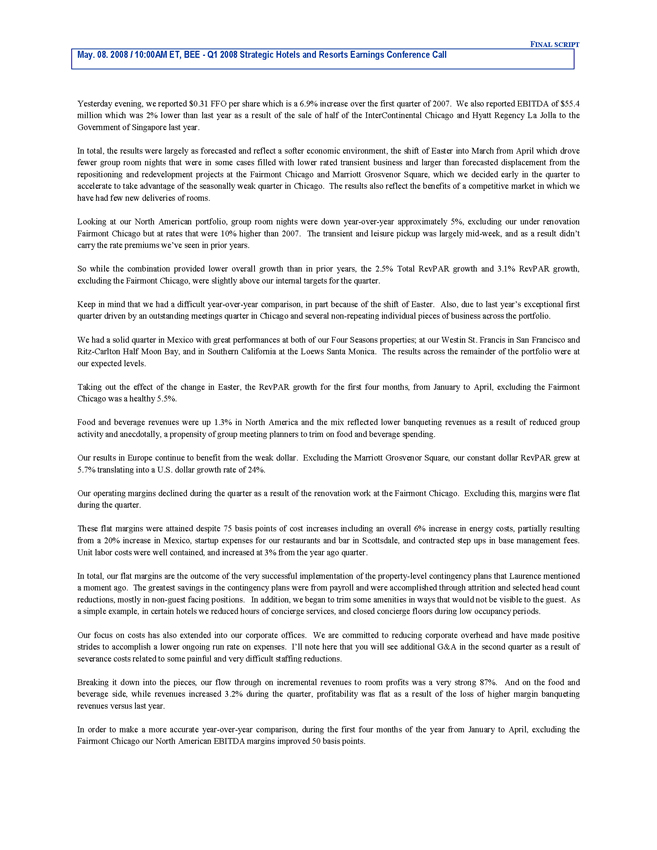
Final script
May. 08. 2008 / 10:00AM ET, BEE - Q1 2008 Strategic Hotels and Resorts Earnings Conference Call
Yesterday evening, we reported $0.31 FFO per share which is a 6.9% increase over the first quarter of 2007. We also reported EBITDA of $55.4 million which was 2% lower than last year as a result of the sale of half of the InterContinental Chicago and Hyatt Regency La Jolla to the Government of Singapore last year.
In total, the results were largely as forecasted and reflect a softer economic environment, the shift of Easter into March from April which drove fewer group room nights that were in some cases filled with lower rated transient business and larger than forecasted displacement from the repositioning and redevelopment projects at the Fairmont Chicago and Marriott Grosvenor Square, which we decided early in the quarter to accelerate to take advantage of the seasonally weak quarter in Chicago. The results also reflect the benefits of a competitive market in which we have had few new deliveries of rooms.
Looking at our North American portfolio, group room nights were down year-over-year approximately 5%, excluding our under renovation Fairmont Chicago but at rates that were 10% higher than 2007. The transient and leisure pickup was largely mid-week, and as a result didn’t carry the rate premiums we’ve seen in prior years.
So while the combination provided lower overall growth than in prior years, the 2.5% Total RevPAR growth and 3.1% RevPAR growth, excluding the Fairmont Chicago, were slightly above our internal targets for the quarter.
Keep in mind that we had a difficult year-over-year comparison, in part because of the shift of Easter. Also, due to last year’s exceptional first quarter driven by an outstanding meetings quarter in Chicago and several non-repeating individual pieces of business across the portfolio.
We had a solid quarter in Mexico with great performances at both of our Four Seasons properties; at our Westin St. Francis in San Francisco and Ritz-Carlton Half Moon Bay, and in Southern California at the Loews Santa Monica. The results across the remainder of the portfolio were at our expected levels.
Taking out the effect of the change in Easter, the RevPAR growth for the first four months, from January to April, excluding the Fairmont Chicago was a healthy 5.5%.
Food and beverage revenues were up 1.3% in North America and the mix reflected lower banqueting revenues as a result of reduced group activity and anecdotally, a propensity of group meeting planners to trim on food and beverage spending.
Our results in Europe continue to benefit from the weak dollar. Excluding the Marriott Grosvenor Square, our constant dollar RevPAR grew at 5.7% translating into a U.S. dollar growth rate of 24%.
Our operating margins declined during the quarter as a result of the renovation work at the Fairmont Chicago. Excluding this, margins were flat during the quarter.
These flat margins were attained despite 75 basis points of cost increases including an overall 6% increase in energy costs, partially resulting from a 20% increase in Mexico, startup expenses for our restaurants and bar in Scottsdale, and contracted step ups in base management fees. Unit labor costs were well contained, and increased at 3% from the year ago quarter.
In total, our flat margins are the outcome of the very successful implementation of the property-level contingency plans that Laurence mentioned a moment ago. The greatest savings in the contingency plans were from payroll and were accomplished through attrition and selected head count reductions, mostly in non-guest facing positions. In addition, we began to trim some amenities in ways that would not be visible to the guest. As a simple example, in certain hotels we reduced hours of concierge services, and closed concierge floors during low occupancy periods.
Our focus on costs has also extended into our corporate offices. We are committed to reducing corporate overhead and have made positive strides to accomplish a lower ongoing run rate on expenses. I’ll note here that you will see additional G&A in the second quarter as a result of severance costs related to some painful and very difficult staffing reductions.
Breaking it down into the pieces, our flow through on incremental revenues to room profits was a very strong 87%. And on the food and beverage side, while revenues increased 3.2% during the quarter, profitability was flat as a result of the loss of higher margin banqueting revenues versus last year.
In order to make a more accurate year-over-year comparison, during the first four months of the year from January to April, excluding the Fairmont Chicago our North American EBITDA margins improved 50 basis points.
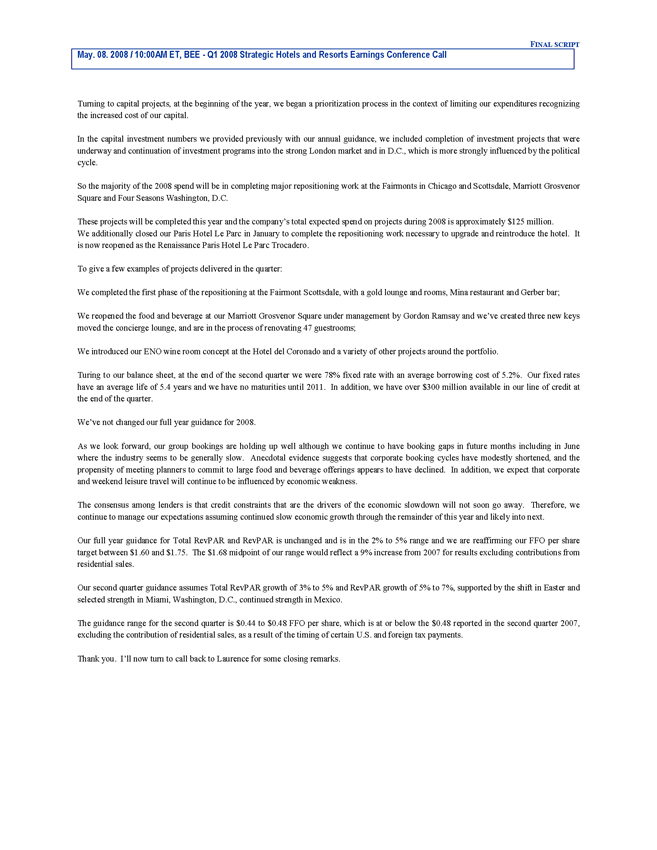
Final script
May. 08. 2008 / 10:00AM ET, BEE - Q1 2008 Strategic Hotels and Resorts Earnings Conference Call
Turning to capital projects, at the beginning of the year, we began a prioritization process in the context of limiting our expenditures recognizing the increased cost of our capital.
In the capital investment numbers we provided previously with our annual guidance, we included completion of investment projects that were underway and continuation of investment programs into the strong London market and in D.C., which is more strongly influenced by the political cycle.
So the majority of the 2008 spend will be in completing major repositioning work at the Fairmonts in Chicago and Scottsdale, Marriott Grosvenor Square and Four Seasons Washington, D.C.
These projects will be completed this year and the company’s total expected spend on projects during 2008 is approximately $125 million.
We additionally closed our Paris Hotel Le Parc in January to complete the repositioning work necessary to upgrade and reintroduce the hotel. It is now reopened as the Renaissance Paris Hotel Le Parc Trocadero.
To give a few examples of projects delivered in the quarter:
We completed the first phase of the repositioning at the Fairmont Scottsdale, with a gold lounge and rooms, Mina restaurant and Gerber bar;
We reopened the food and beverage at our Marriott Grosvenor Square under management by Gordon Ramsay and we’ve created three new keys moved the concierge lounge, and are in the process of renovating 47 guestrooms;
We introduced our ENO wine room concept at the Hotel del Coronado and a variety of other projects around the portfolio.
Turing to our balance sheet, at the end of the second quarter we were 78% fixed rate with an average borrowing cost of 5.2%. Our fixed rates have an average life of 5.4 years and we have no maturities until 2011. In addition, we have over $300 million available in our line of credit at the end of the quarter.
We’ve not changed our full year guidance for 2008.
As we look forward, our group bookings are holding up well although we continue to have booking gaps in future months including in June where the industry seems to be generally slow. Anecdotal evidence suggests that corporate booking cycles have modestly shortened, and the propensity of meeting planners to commit to large food and beverage offerings appears to have declined. In addition, we expect that corporate and weekend leisure travel will continue to be influenced by economic weakness.
The consensus among lenders is that credit constraints that are the drivers of the economic slowdown will not soon go away. Therefore, we continue to manage our expectations assuming continued slow economic growth through the remainder of this year and likely into next.
Our full year guidance for Total RevPAR and RevPAR is unchanged and is in the 2% to 5% range and we are reaffirming our FFO per share target between $1.60 and $1.75. The $1.68 midpoint of our range would reflect a 9% increase from 2007 for results excluding contributions from residential sales.
Our second quarter guidance assumes Total RevPAR growth of 3% to 5% and RevPAR growth of 5% to 7%, supported by the shift in Easter and selected strength in Miami, Washington, D.C., continued strength in Mexico.
The guidance range for the second quarter is $0.44 to $0.48 FFO per share, which is at or below the $0.48 reported in the second quarter 2007, excluding the contribution of residential sales, as a result of the timing of certain U.S. and foreign tax payments.
Thank you. I’ll now turn to call back to Laurence for some closing remarks.
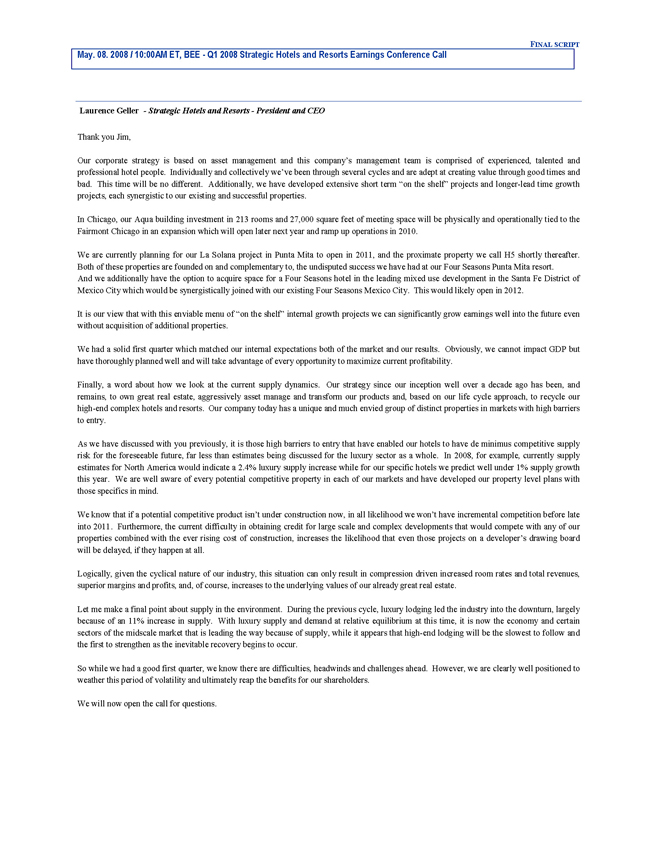
Final script
May. 08. 2008 / 10:00AM ET, BEE - Q1 2008 Strategic Hotels and Resorts Earnings Conference Call
Laurence Geller —Strategic Hotels and Resorts—President and CEO
Thank you Jim,
Our corporate strategy is based on asset management and this company’s management team is comprised of experienced, talented and professional hotel people. Individually and collectively we’ve been through several cycles and are adept at creating value through good times and bad. This time will be no different. Additionally, we have developed extensive short term “on the shelf” projects and longer-lead time growth projects, each synergistic to our existing and successful properties.
In Chicago, our Aqua building investment in 213 rooms and 27,000 square feet of meeting space will be physically and operationally tied to the Fairmont Chicago in an expansion which will open later next year and ramp up operations in 2010.
We are currently planning for our La Solana project in Punta Mita to open in 2011, and the proximate property we call H5 shortly thereafter. Both of these properties are founded on and complementary to, the undisputed success we have had at our Four Seasons Punta Mita resort. And we additionally have the option to acquire space for a Four Seasons hotel in the leading mixed use development in the Santa Fe District of Mexico City which would be synergistically joined with our existing Four Seasons Mexico City. This would likely open in 2012.
It is our view that with this enviable menu of “on the shelf” internal growth projects we can significantly grow earnings well into the future even without acquisition of additional properties.
We had a solid first quarter which matched our internal expectations both of the market and our results. Obviously, we cannot impact GDP but have thoroughly planned well and will take advantage of every opportunity to maximize current profitability.
Finally, a word about how we look at the current supply dynamics. Our strategy since our inception well over a decade ago has been, and remains, to own great real estate, aggressively asset manage and transform our products and, based on our life cycle approach, to recycle our high-end complex hotels and resorts. Our company today has a unique and much envied group of distinct properties in markets with high barriers to entry.
As we have discussed with you previously, it is those high barriers to entry that have enabled our hotels to have de minimus competitive supply risk for the foreseeable future, far less than estimates being discussed for the luxury sector as a whole. In 2008, for example, currently supply estimates for North America would indicate a 2.4% luxury supply increase while for our specific hotels we predict well under 1% supply growth this year. We are well aware of every potential competitive property in each of our markets and have developed our property level plans with those specifics in mind.
We know that if a potential competitive product isn’t under construction now, in all likelihood we won’t have incremental competition before late into 2011. Furthermore, the current difficulty in obtaining credit for large scale and complex developments that would compete with any of our properties combined with the ever rising cost of construction, increases the likelihood that even those projects on a developer’s drawing board will be delayed, if they happen at all.
Logically, given the cyclical nature of our industry, this situation can only result in compression driven increased room rates and total revenues, superior margins and profits, and, of course, increases to the underlying values of our already great real estate.
Let me make a final point about supply in the environment. During the previous cycle, luxury lodging led the industry into the downturn, largely because of an 11% increase in supply. With luxury supply and demand at relative equilibrium at this time, it is now the economy and certain sectors of the midscale market that is leading the way because of supply, while it appears that high-end lodging will be the slowest to follow and the first to strengthen as the inevitable recovery begins to occur.
So while we had a good first quarter, we know there are difficulties, headwinds and challenges ahead. However, we are clearly well positioned to weather this period of volatility and ultimately reap the benefits for our shareholders.
We will now open the call for questions.
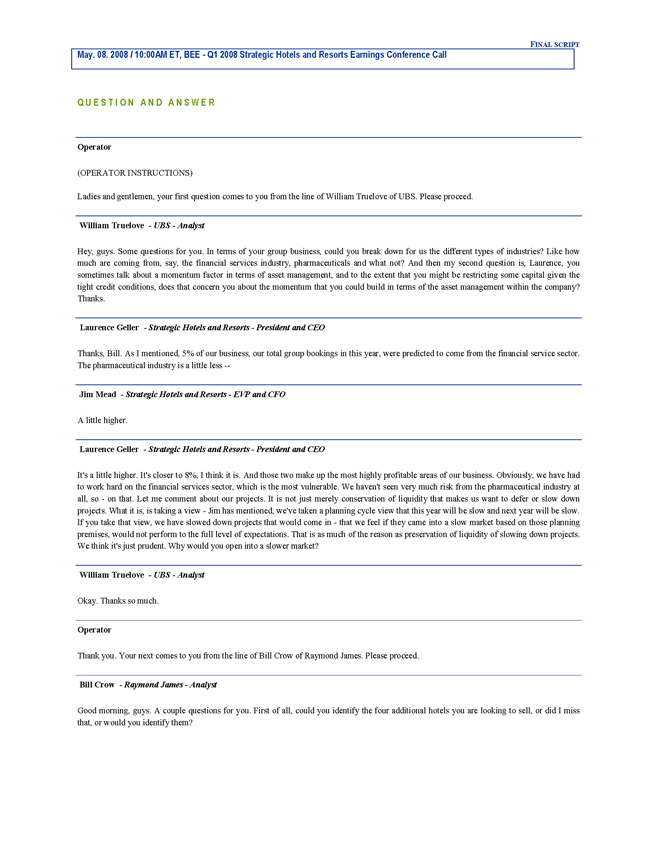
Final script
May. 08. 2008 / 10:00AM ET, BEE - Q1 2008 Strategic Hotels and Resorts Earnings Conference Call
QUESTION AND ANSWER
Operator
(OPERATOR INSTRUCTIONS)
Ladies and gentlemen, your first question comes to you from the line of William Truelove of UBS. Please proceed.
William Truelove —UBS—Analyst
Hey, guys. Some questions for you. In terms of your group business, could you break down for us the different types of industries? Like how much are coming from, say, the financial services industry, pharmaceuticals and what not? And then my second question is, Laurence, you sometimes talk about a momentum factor in terms of asset management, and to the extent that you might be restricting some capital given the tight credit conditions, does that concern you about the momentum that you could build in terms of the asset management within the company? Thanks.
Laurence Geller —Strategic Hotels and Resorts—President and CEO
Thanks, Bill. As I mentioned, 5% of our business, our total group bookings in this year, were predicted to come from the financial service sector. The pharmaceutical industry is a little less —
Jim Mead —Strategic Hotels and Resorts—EVP and CFO
A little higher.
Laurence Geller —Strategic Hotels and Resorts—President and CEO
It’s a little higher. It’s closer to 8%, I think it is. And those two make up the most highly profitable areas of our business. Obviously, we have had to work hard on the financial services sector, which is the most vulnerable. We haven’t seen very much risk from the pharmaceutical industry at all, so—on that. Let me comment about our projects. It is not just merely conservation of liquidity that makes us want to defer or slow down projects. What it is, is taking a view—Jim has mentioned, we’ve taken a planning cycle view that this year will be slow and next year will be slow. If you take that view, we have slowed down projects that would come in—that we feel if they came into a slow market based on those planning premises, would not perform to the full level of expectations. That is as much of the reason as preservation of liquidity of slowing down projects. We think it’s just prudent. Why would you open into a slower market?
William Truelove —UBS—Analyst
Okay. Thanks so much.
Operator
Thank you. Your next comes to you from the line of Bill Crow of Raymond James. Please proceed.
Bill Crow —Raymond James—Analyst
Good morning, guys. A couple questions for you. First of all, could you identify the four additional hotels you are looking to sell, or did I miss that, or would you identify them?
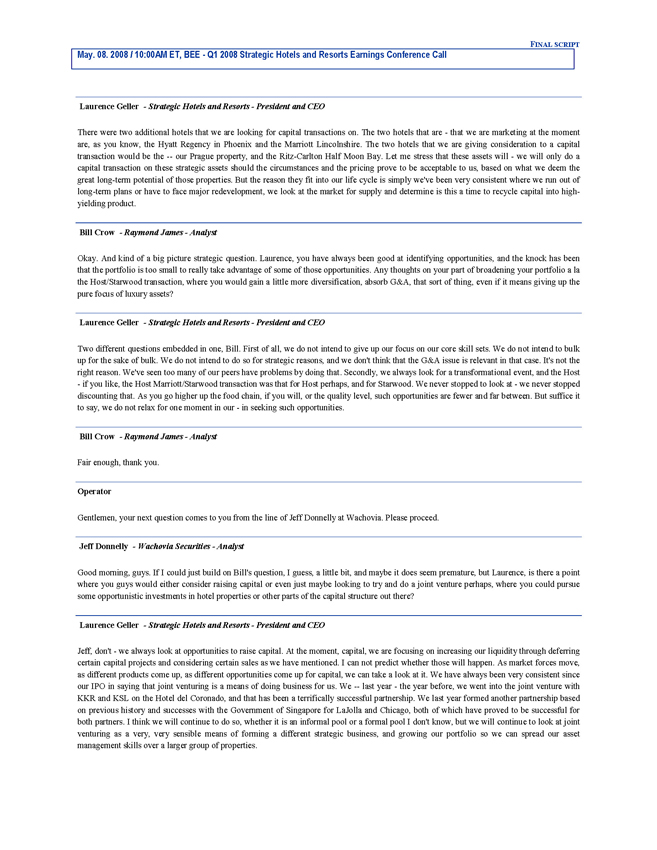
Final script
May. 08. 2008 / 10:00AM ET, BEE - Q1 2008 Strategic Hotels and Resorts Earnings Conference Call
Laurence Geller —Strategic Hotels and Resorts—President and CEO
There were two additional hotels that we are looking for capital transactions on. The two hotels that are—that we are marketing at the moment are, as you know, the Hyatt Regency in Phoenix and the Marriott Lincolnshire. The two hotels that we are giving consideration to a capital transaction would be the — our Prague property, and the Ritz-Carlton Half Moon Bay. Let me stress that these assets will—we will only do a capital transaction on these strategic assets should the circumstances and the pricing prove to be acceptable to us, based on what we deem the great long-term potential of those properties. But the reason they fit into our life cycle is simply we’ve been very consistent where we run out of long-term plans or have to face major redevelopment, we look at the market for supply and determine is this a time to recycle capital into high-yielding product.
Bill Crow —Raymond James—Analyst
Okay. And kind of a big picture strategic question. Laurence, you have always been good at identifying opportunities, and the knock has been that the portfolio is too small to really take advantage of some of those opportunities. Any thoughts on your part of broadening your portfolio a la the Host/Starwood transaction, where you would gain a little more diversification, absorb G&A, that sort of thing, even if it means giving up the pure focus of luxury assets?
Laurence Geller —Strategic Hotels and Resorts—President and CEO
Two different questions embedded in one, Bill. First of all, we do not intend to give up our focus on our core skill sets. We do not intend to bulk up for the sake of bulk. We do not intend to do so for strategic reasons, and we don’t think that the G&A issue is relevant in that case. It’s not the right reason. We’ve seen too many of our peers have problems by doing that. Secondly, we always look for a transformational event, and the Host—if you like, the Host Marriott/Starwood transaction was that for Host perhaps, and for Starwood. We never stopped to look at—we never stopped discounting that. As you go higher up the food chain, if you will, or the quality level, such opportunities are fewer and far between. But suffice it to say, we do not relax for one moment in our—in seeking such opportunities.
Bill Crow —Raymond James—Analyst
Fair enough, thank you.
Operator
Gentlemen, your next question comes to you from the line of Jeff Donnelly at Wachovia. Please proceed.
Jeff Donnelly —Wachovia Securities—Analyst
Good morning, guys. If I could just build on Bill’s question, I guess, a little bit, and maybe it does seem premature, but Laurence, is there a point where you guys would either consider raising capital or even just maybe looking to try and do a joint venture perhaps, where you could pursue some opportunistic investments in hotel properties or other parts of the capital structure out there?
Laurence Geller —Strategic Hotels and Resorts—President and CEO
Jeff, don’t—we always look at opportunities to raise capital. At the moment, capital, we are focusing on increasing our liquidity through deferring certain capital projects and considering certain sales as we have mentioned. I can not predict whether those will happen. As market forces move, as different products come up, as different opportunities come up for capital, we can take a look at it. We have always been very consistent since our IPO in saying that joint venturing is a means of doing business for us. We — last year—the year before, we went into the joint venture with KKR and KSL on the Hotel del Coronado, and that has been a terrifically successful partnership. We last year formed another partnership based on previous history and successes with the Government of Singapore for LaJolla and Chicago, both of which have proved to be successful for both partners. I think we will continue to do so, whether it is an informal pool or a formal pool I don’t know, but we will continue to look at joint venturing as a very, very sensible means of forming a different strategic business, and growing our portfolio so we can spread our asset management skills over a larger group of properties.
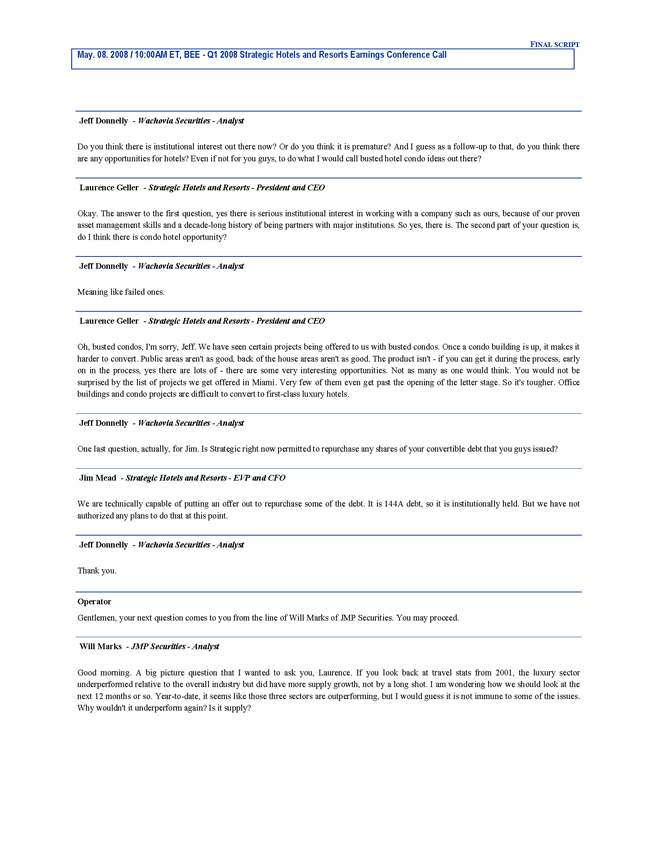
Final script
May. 08. 2008 / 10:00AM ET, BEE - Q1 2008 Strategic Hotels and Resorts Earnings Conference Call
Jeff Donnelly —Wachovia Securities—Analyst
Do you think there is institutional interest out there now? Or do you think it is premature? And I guess as a follow-up to that, do you think there are any opportunities for hotels? Even if not for you guys, to do what I would call busted hotel condo ideas out there?
Laurence Geller —Strategic Hotels and Resorts—President and CEO
Okay. The answer to the first question, yes there is serious institutional interest in working with a company such as ours, because of our proven asset management skills and a decade-long history of being partners with major institutions. So yes, there is. The second part of your question is, do I think there is condo hotel opportunity?
Jeff Donnelly —Wachovia Securities—Analyst
Meaning like failed ones.
Laurence Geller —Strategic Hotels and Resorts—President and CEO
Oh, busted condos, I’m sorry, Jeff. We have seen certain projects being offered to us with busted condos. Once a condo building is up, it makes it harder to convert. Public areas aren’t as good, back of the house areas aren’t as good. The product isn’t—if you can get it during the process, early on in the process, yes there are lots of—there are some very interesting opportunities. Not as many as one would think. You would not be surprised by the list of projects we get offered in Miami. Very few of them even get past the opening of the letter stage. So it’s tougher. Office buildings and condo projects are difficult to convert to first-class luxury hotels.
Jeff Donnelly —Wachovia Securities—Analyst
One last question, actually, for Jim. Is Strategic right now permitted to repurchase any shares of your convertible debt that you guys issued?
Jim Mead —Strategic Hotels and Resorts—EVP and CFO
We are technically capable of putting an offer out to repurchase some of the debt. It is 144A debt, so it is institutionally held. But we have not authorized any plans to do that at this point.
Jeff Donnelly —Wachovia Securities—Analyst
Thank you.
Operator
Gentlemen, your next question comes to you from the line of Will Marks of JMP Securities. You may proceed.
Will Marks —JMP Securities—Analyst
Good morning. A big picture question that I wanted to ask you, Laurence. If you look back at travel stats from 2001, the luxury sector underperformed relative to the overall industry but did have more supply growth, not by a long shot. I am wondering how we should look at the next 12 months or so. Year-to-date, it seems like those three sectors are outperforming, but I would guess it is not immune to some of the issues. Why wouldn’t it underperform again? Is it supply?
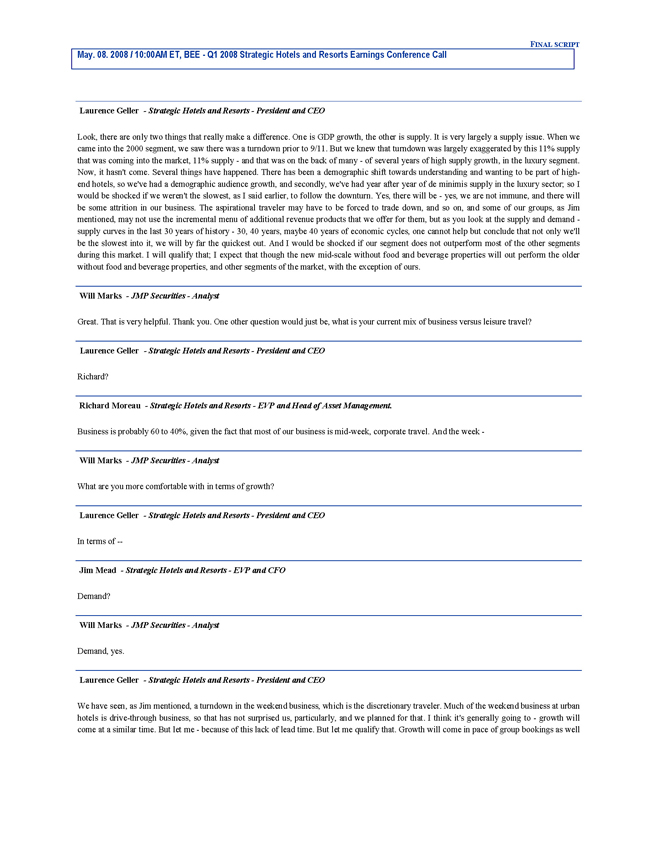
Laurence Geller —Strategic Hotels and Resorts—President and CEO
Look, there are only two things that really make a difference. One is GDP growth, the other is supply. It is very largely a supply issue. When we came into the 2000 segment, we saw there was a turndown prior to 9/11. But we knew that turndown was largely exaggerated by this 11% supply that was coming into the market, 11% supply—and that was on the back of many—of several years of high supply growth, in the luxury segment. Now, it hasn’t come. Several things have happened. There has been a demographic shift towards understanding and wanting to be part of high-end hotels, so we’ve had a demographic audience growth, and secondly, we’ve had year after year of de minimis supply in the luxury sector; so I would be shocked if we weren’t the slowest, as I said earlier, to follow the downturn. Yes, there will be—yes, we are not immune, and there will be some attrition in our business. The aspirational traveler may have to be forced to trade down, and so on, and some of our groups, as Jim mentioned, may not use the incremental menu of additional revenue products that we offer for them, but as you look at the supply and demand—supply curves in the last 30 years of history—30, 40 years, maybe 40 years of economic cycles, one cannot help but conclude that not only we’ll be the slowest into it, we will by far the quickest out. And I would be shocked if our segment does not outperform most of the other segments during this market. I will qualify that; I expect that though the new mid-scale without food and beverage properties will out perform the older without food and beverage properties, and other segments of the market, with the exception of ours.
Will Marks —JMP Securities—Analyst
Great. That is very helpful. Thank you. One other question would just be, what is your current mix of business versus leisure travel?
Laurence Geller —Strategic Hotels and Resorts—President and CEO
Richard?
Richard Moreau —Strategic Hotels and Resorts—EVP and Head of Asset Management.
Business is probably 60 to 40%, given the fact that most of our business is mid-week, corporate travel. And the week -
Will Marks —JMP Securities—Analyst
What are you more comfortable with in terms of growth?
Laurence Geller —Strategic Hotels and Resorts—President and CEO
In terms of —
Jim Mead —Strategic Hotels and Resorts—EVP and CFO
Demand?
Will Marks —JMP Securities—Analyst
Demand, yes.
Laurence Geller —Strategic Hotels and Resorts—President and CEO
We have seen, as Jim mentioned, a turndown in the weekend business, which is the discretionary traveler. Much of the weekend business at urban hotels is drive-through business, so that has not surprised us, particularly, and we planned for that. I think it’s generally going to—growth will come at a similar time. But let me—because of this lack of lead time. But let me qualify that. Growth will come in pace of group bookings as well as immediate use of rooms amongst the corporate and leisure. So that is how it works out. I think the corporate business will probably come back marginally quicker than leisure business, and gasoline pricing has something to do with that.
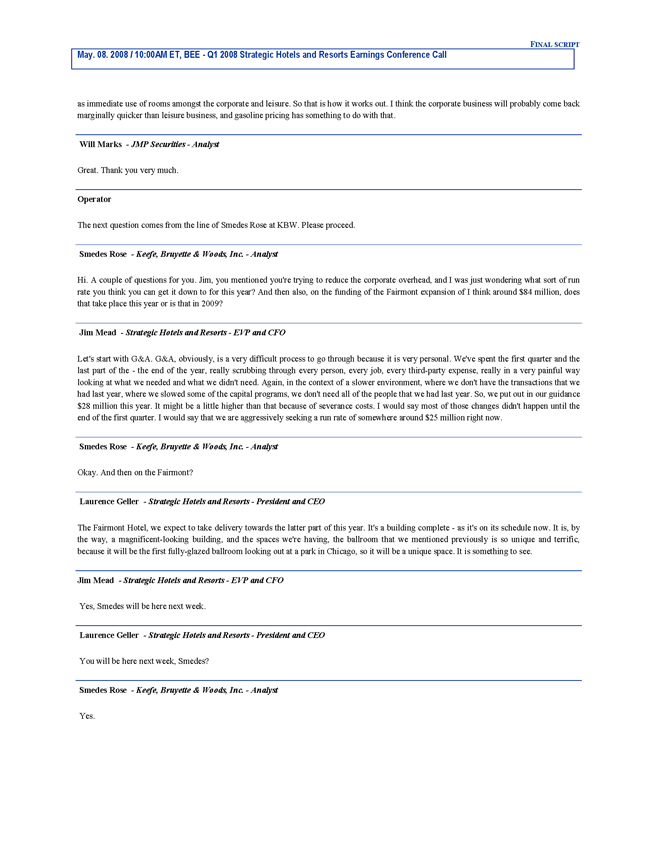
Final script
May. 08. 2008 / 10:00AM ET, BEE - Q1 2008 Strategic Hotels and Resorts Earnings Conference Call
Will Marks —JMP Securities—Analyst
Great. Thank you very much.
Operator
The next question comes from the line of Smedes Rose at KBW. Please proceed.
Smedes Rose —Keefe, Bruyette & Woods, Inc.—Analyst
Hi. A couple of questions for you. Jim, you mentioned you’re trying to reduce the corporate overhead, and I was just wondering what sort of run rate you think you can get it down to for this year? And then also, on the funding of the Fairmont expansion of I think around $84 million, does that take place this year or is that in 2009?
Jim Mead —Strategic Hotels and Resorts—EVP and CFO
Let’s start with G&A. G&A, obviously, is a very difficult process to go through because it is very personal. We’ve spent the first quarter and the last part of the—the end of the year, really scrubbing through every person, every job, every third-party expense, really in a very painful way looking at what we needed and what we didn’t need. Again, in the context of a slower environment, where we don’t have the transactions that we had last year, where we slowed some of the capital programs, we don’t need all of the people that we had last year. So, we put out in our guidance $28 million this year. It might be a little higher than that because of severance costs. I would say most of those changes didn’t happen until the end of the first quarter. I would say that we are aggressively seeking a run rate of somewhere around $25 million right now.
Smedes Rose —Keefe, Bruyette & Woods, Inc.—Analyst
Okay. And then on the Fairmont?
Laurence Geller —Strategic Hotels and Resorts—President and CEO
The Fairmont Hotel, we expect to take delivery towards the latter part of this year. It’s a building complete—as it’s on its schedule now. It is, by the way, a magnificent-looking building, and the spaces we’re having, the ballroom that we mentioned previously is so unique and terrific, because it will be the first fully-glazed ballroom looking out at a park in Chicago, so it will be a unique space. It is something to see.
Jim Mead —Strategic Hotels and Resorts—EVP and CFO
Yes, Smedes will be here next week.
Laurence Geller —Strategic Hotels and Resorts—President and CEO
You will be here next week, Smedes?
Smedes Rose —Keefe, Bruyette & Woods, Inc.—Analyst
Yes.
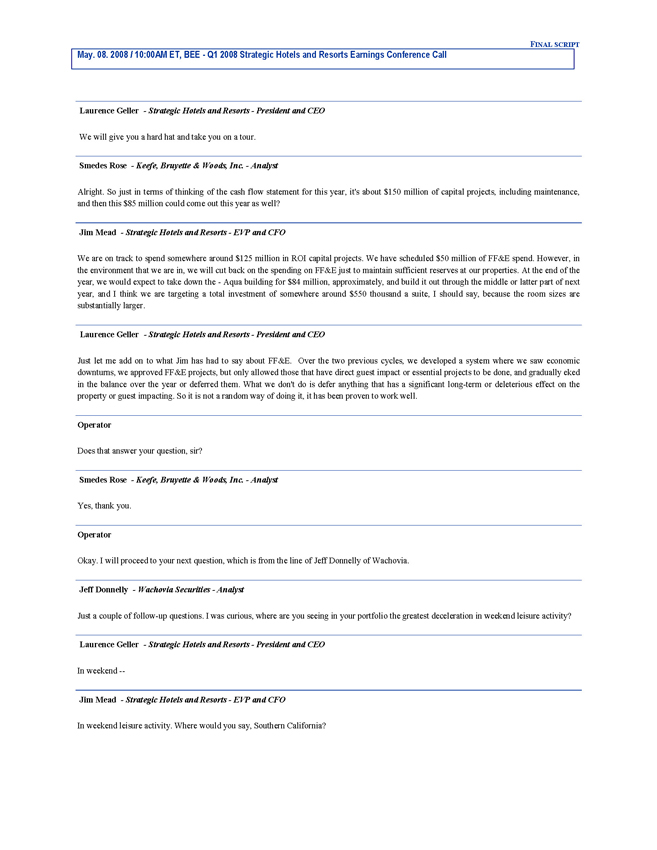
Final script
May. 08. 2008 / 10:00AM ET, BEE - Q1 2008 Strategic Hotels and Resorts Earnings Conference Call
Laurence Geller —Strategic Hotels and Resorts—President and CEO
We will give you a hard hat and take you on a tour.
Smedes Rose —Keefe, Bruyette & Woods, Inc.—Analyst
Alright. So just in terms of thinking of the cash flow statement for this year, it’s about $150 million of capital projects, including maintenance, and then this $85 million could come out this year as well?
Jim Mead —Strategic Hotels and Resorts—EVP and CFO
We are on track to spend somewhere around $125 million in ROI capital projects. We have scheduled $50 million of FF&E spend. However, in the environment that we are in, we will cut back on the spending on FF&E just to maintain sufficient reserves at our properties. At the end of the year, we would expect to take down the—Aqua building for $84 million, approximately, and build it out through the middle or latter part of next year, and I think we are targeting a total investment of somewhere around $550 thousand a suite, I should say, because the room sizes are substantially larger.
Laurence Geller —Strategic Hotels and Resorts—President and CEO
Just let me add on to what Jim has had to say about FF&E. Over the two previous cycles, we developed a system where we saw economic downturns, we approved FF&E projects, but only allowed those that have direct guest impact or essential projects to be done, and gradually eked in the balance over the year or deferred them. What we don’t do is defer anything that has a significant long-term or deleterious effect on the property or guest impacting. So it is not a random way of doing it, it has been proven to work well.
Operator
Does that answer your question, sir?
Smedes Rose —Keefe, Bruyette & Woods, Inc.—Analyst
Yes, thank you.
Operator
Okay. I will proceed to your next question, which is from the line of Jeff Donnelly of Wachovia.
Jeff Donnelly —Wachovia Securities—Analyst
Just a couple of follow-up questions. I was curious, where are you seeing in your portfolio the greatest deceleration in weekend leisure activity?
Laurence Geller —Strategic Hotels and Resorts—President and CEO
In weekend —
Jim Mead —Strategic Hotels and Resorts—EVP and CFO
In weekend leisure activity. Where would you say, Southern California?
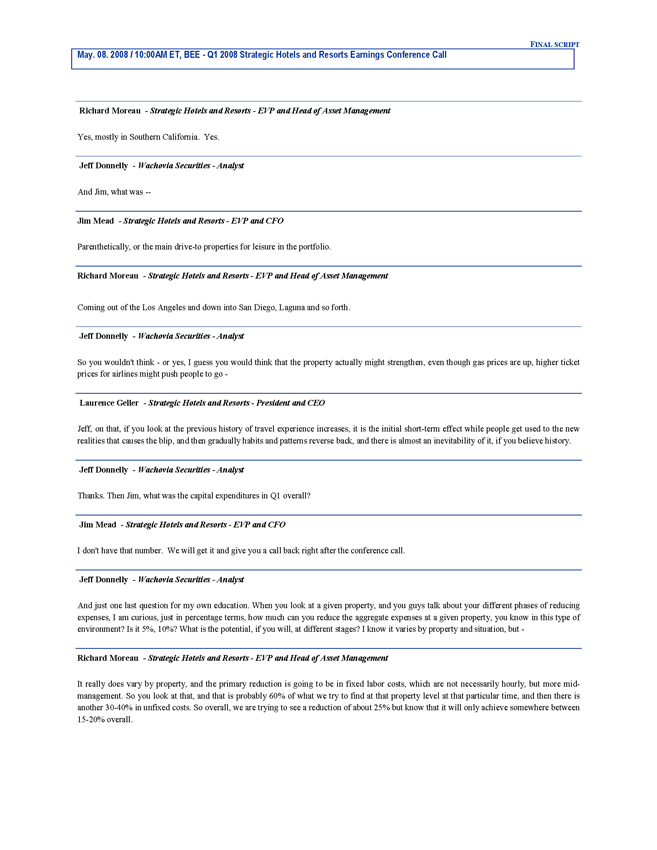
Final script
May. 08. 2008 / 10:00AM ET, BEE - Q1 2008 Strategic Hotels and Resorts Earnings Conference Call
Richard Moreau —Strategic Hotels and Resorts—EVP and Head of Asset Management
Yes, mostly in Southern California. Yes.
Jeff Donnelly —Wachovia Securities—Analyst
And Jim, what was —
Jim Mead —Strategic Hotels and Resorts—EVP and CFO
Parenthetically, or the main drive-to properties for leisure in the portfolio.
Richard Moreau —Strategic Hotels and Resorts—EVP and Head of Asset Management
Coming out of the Los Angeles and down into San Diego, Laguna and so forth.
Jeff Donnelly —Wachovia Securities—Analyst
So you wouldn’t think—or yes, I guess you would think that the property actually might strengthen, even though gas prices are up, higher ticket prices for airlines might push people to go -
Laurence Geller —Strategic Hotels and Resorts—President and CEO
Jeff, on that, if you look at the previous history of travel experience increases, it is the initial short-term effect while people get used to the new realities that causes the blip, and then gradually habits and patterns reverse back, and there is almost an inevitability of it, if you believe history.
Jeff Donnelly —Wachovia Securities—Analyst
Thanks. Then Jim, what was the capital expenditures in Q1 overall?
Jim Mead —Strategic Hotels and Resorts—EVP and CFO
I don’t have that number. We will get it and give you a call back right after the conference call.
Jeff Donnelly —Wachovia Securities—Analyst
And just one last question for my own education. When you look at a given property, and you guys talk about your different phases of reducing expenses, I am curious, just in percentage terms, how much can you reduce the aggregate expenses at a given property, you know in this type of environment? Is it 5%, 10%? What is the potential, if you will, at different stages? I know it varies by property and situation, but -
Richard Moreau —Strategic Hotels and Resorts—EVP and Head of Asset Management
It really does vary by property, and the primary reduction is going to be in fixed labor costs, which are not necessarily hourly, but more mid-management. So you look at that, and that is probably 60% of what we try to find at that property level at that particular time, and then there is another 30-40% in unfixed costs. So overall, we are trying to see a reduction of about 25% but know that it will only achieve somewhere between 15-20% overall.
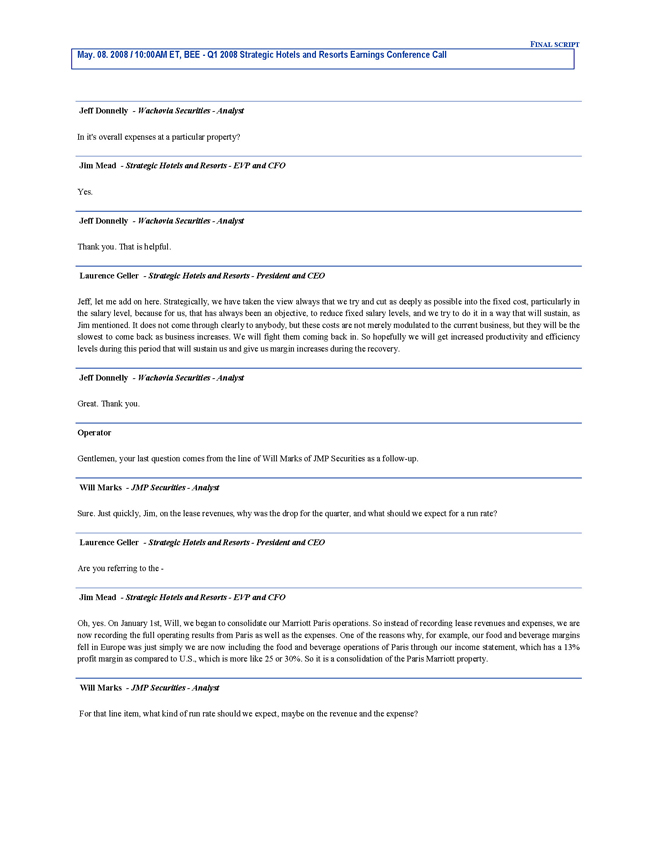
Final script
May. 08. 2008 / 10:00AM ET, BEE - Q1 2008 Strategic Hotels and Resorts Earnings Conference Call
Jeff Donnelly —Wachovia Securities—Analyst
In it’s overall expenses at a particular property?
Jim Mead —Strategic Hotels and Resorts—EVP and CFO
Yes.
Jeff Donnelly —Wachovia Securities—Analyst
Thank you. That is helpful.
Laurence Geller —Strategic Hotels and Resorts—President and CEO
Jeff, let me add on here. Strategically, we have taken the view always that we try and cut as deeply as possible into the fixed cost, particularly in the salary level, because for us, that has always been an objective, to reduce fixed salary levels, and we try to do it in a way that will sustain, as Jim mentioned. It does not come through clearly to anybody, but these costs are not merely modulated to the current business, but they will be the slowest to come back as business increases. We will fight them coming back in. So hopefully we will get increased productivity and efficiency levels during this period that will sustain us and give us margin increases during the recovery.
Jeff Donnelly —Wachovia Securities—Analyst
Great. Thank you.
Operator
Gentlemen, your last question comes from the line of Will Marks of JMP Securities as a follow-up.
Will Marks —JMP Securities—Analyst
Sure. Just quickly, Jim, on the lease revenues, why was the drop for the quarter, and what should we expect for a run rate?
Laurence Geller —Strategic Hotels and Resorts—President and CEO
Are you referring to the -
Jim Mead —Strategic Hotels and Resorts—EVP and CFO
Oh, yes. On January 1st, Will, we began to consolidate our Marriott Paris operations. So instead of recording lease revenues and expenses, we are now recording the full operating results from Paris as well as the expenses. One of the reasons why, for example, our food and beverage margins fell in Europe was just simply we are now including the food and beverage operations of Paris through our income statement, which has a 13% profit margin as compared to U.S., which is more like 25 or 30%. So it is a consolidation of the Paris Marriott property.
Will Marks —JMP Securities—Analyst
For that line item, what kind of run rate should we expect, maybe on the revenue and the expense?
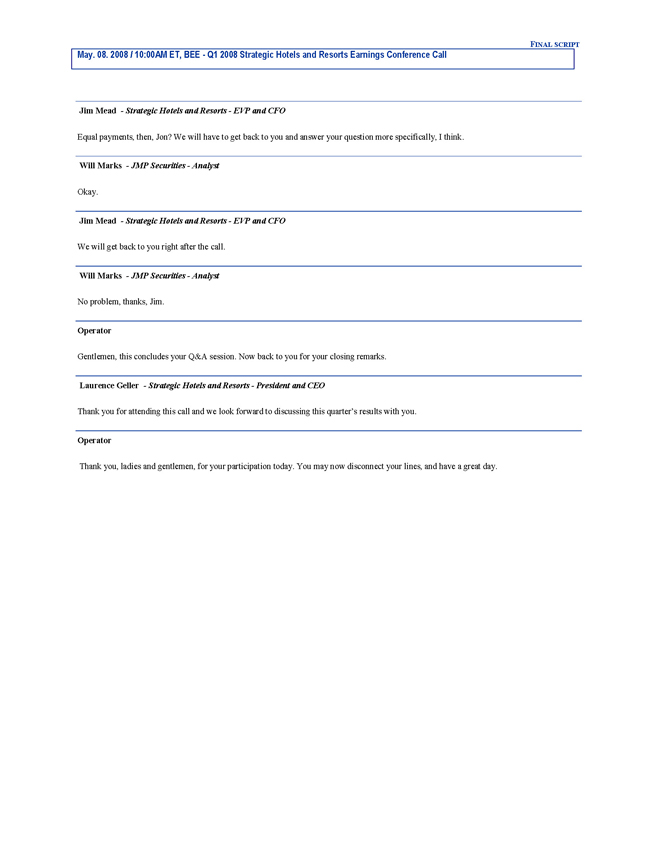
Final script
May. 08. 2008 / 10:00AM ET, BEE - Q1 2008 Strategic Hotels and Resorts Earnings Conference Call
Jim Mead —Strategic Hotels and Resorts—EVP and CFO
Equal payments, then, Jon? We will have to get back to you and answer your question more specifically, I think.
Will Marks —JMP Securities—Analyst
Okay.
Jim Mead —Strategic Hotels and Resorts—EVP and CFO
We will get back to you right after the call.
Will Marks —JMP Securities—Analyst
No problem, thanks, Jim.
Operator
Gentlemen, this concludes your Q&A session. Now back to you for your closing remarks.
Laurence Geller —Strategic Hotels and Resorts—President and CEO
Thank you for attending this call and we look forward to discussing this quarter’s results with you.
Operator
Thank you, ladies and gentlemen, for your participation today. You may now disconnect your lines, and have a great day.















